Abstract
Periodic spikes of decreased optical density were recorded in cell suspensions of Dictyostelium discoideum. Spike formation as well as changes in the redox state of cytochrome b are facultatively and independently coupled to an oscillating system which is under developmental control and presumably underlies signal transmission in aggregating cells.
Cyclic AMP triggers a double response, the slow component resembling the spikes formed during spontaneous oscillations. The fast component shows characteristics of the chemotactic response to cyclic AMP. The receptor system is suggested to sense changes of cyclic AMP concentration in time. Cyclic AMP pulses interact with the oscillating system, resulting in phase shift or suppression of spike formation, and in the induction of oscillations in an early stage of development before the onset of spontaneous oscillations. Continuous flow application of cyclic AMP does not change frequency up to flow rates which extinguish oscillations.
Keywords: chemotaxis, slime molds, cell aggregation, membrane receptors, dissipative structures
Full text
PDF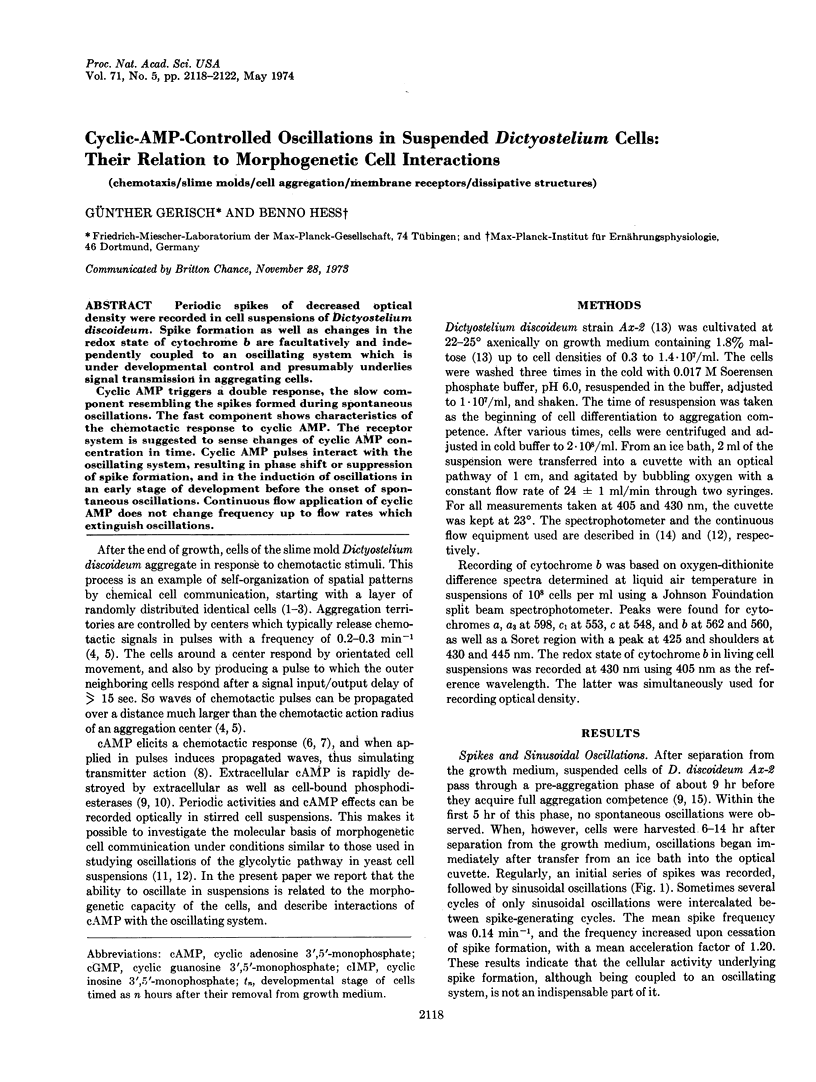
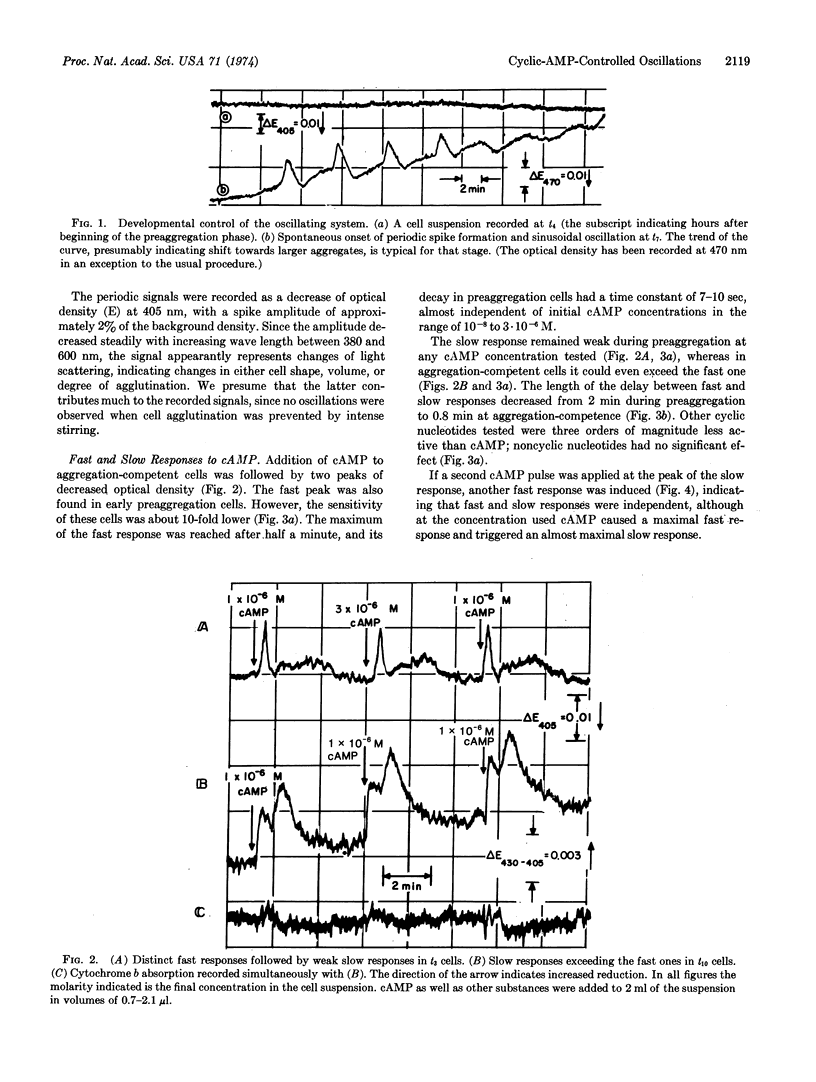
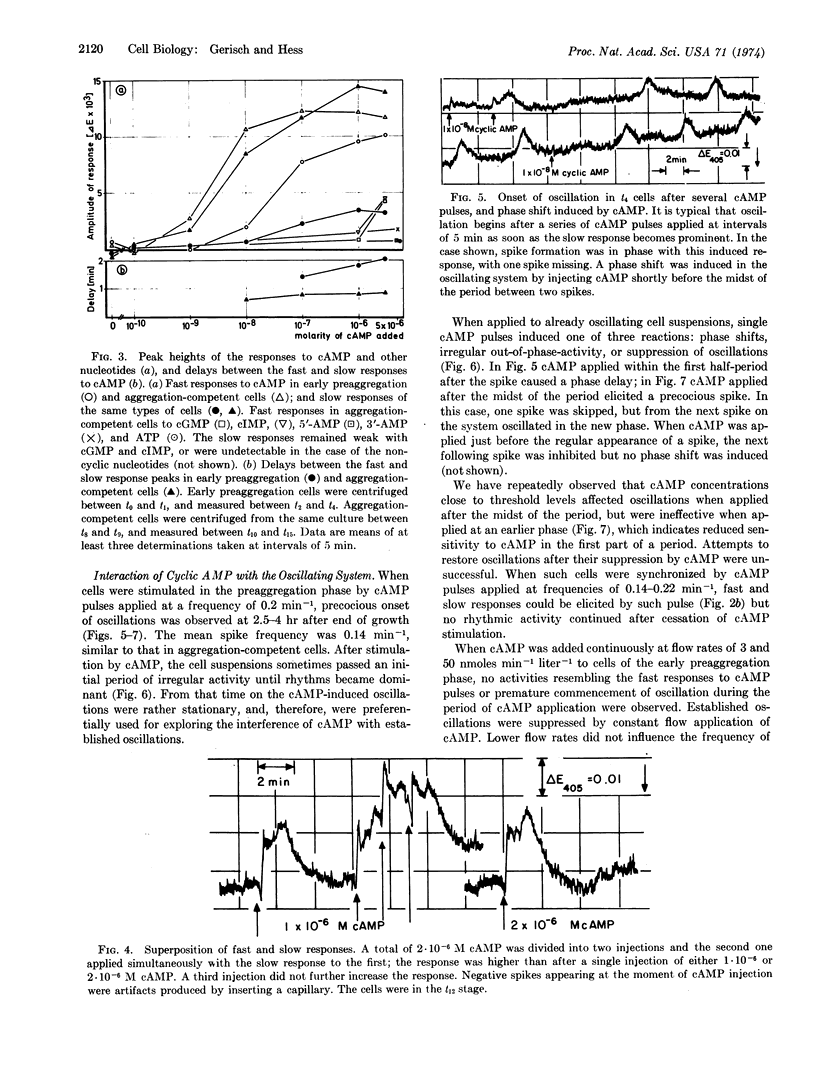
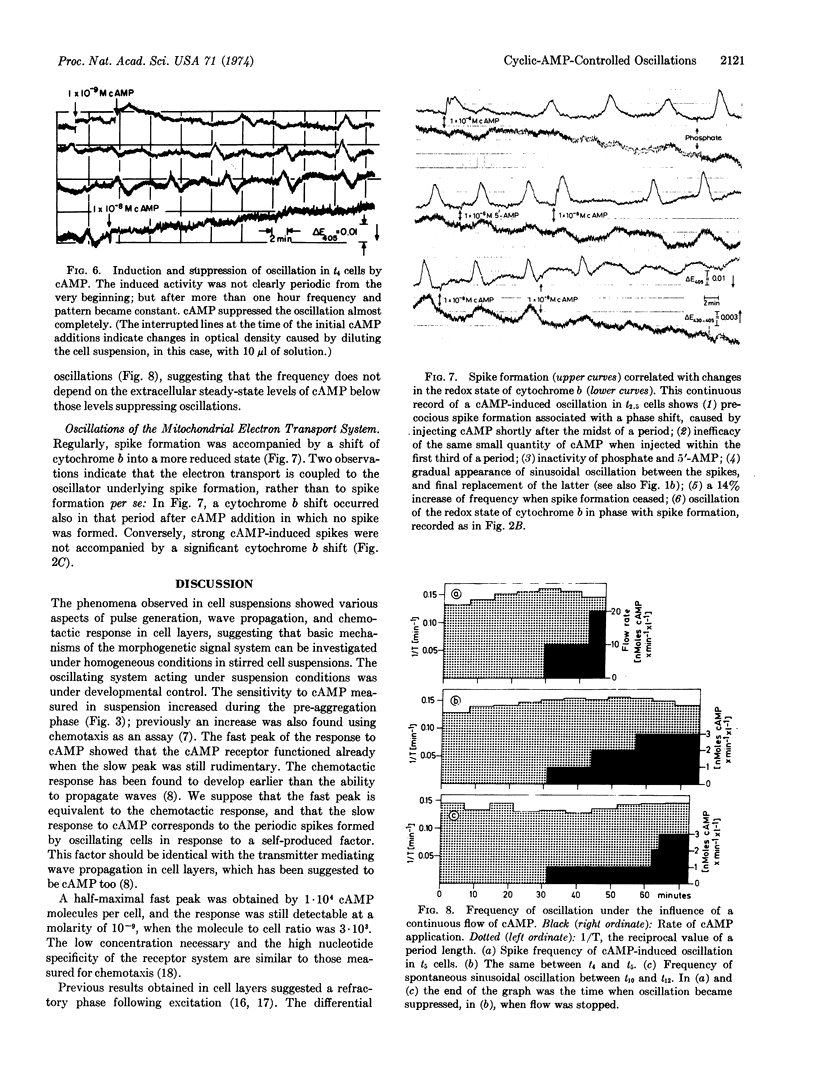
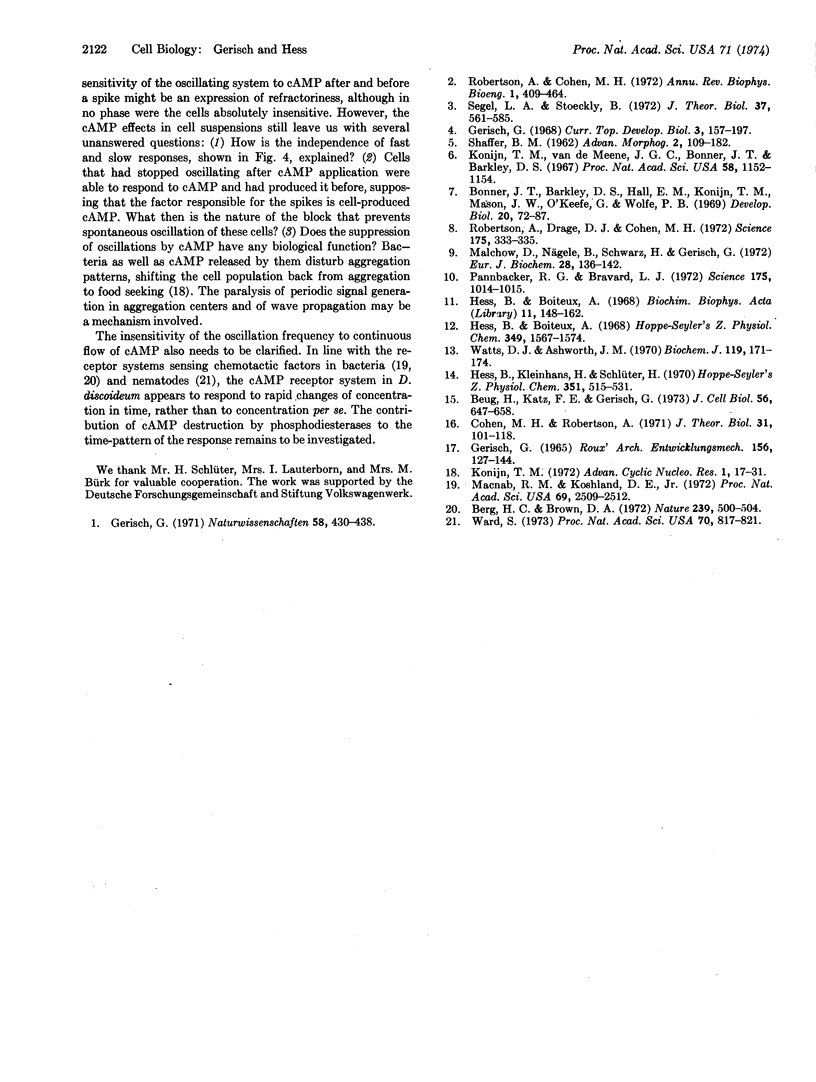
Selected References
These references are in PubMed. This may not be the complete list of references from this article.
- Berg H. C., Brown D. A. Chemotaxis in Escherichia coli analysed by three-dimensional tracking. Nature. 1972 Oct 27;239(5374):500–504. doi: 10.1038/239500a0. [DOI] [PubMed] [Google Scholar]
- Beug H., Katz F. E., Gerisch G. Dynamics of antigenic membrane sites relating to cell aggregation in Dictyostelium discoideum. J Cell Biol. 1973 Mar;56(3):647–658. doi: 10.1083/jcb.56.3.647. [DOI] [PMC free article] [PubMed] [Google Scholar]
- Bonner J. T., Barkley D. S., Hall E. M., Konijn T. M., Mason J. W., O'Keefe G., 3rd, Wolfe P. B. Acrasin, Acrasinase, and the sensitivity to acrasin in Dictyostelium discoideum. Dev Biol. 1969 Jul;20(1):72–87. doi: 10.1016/0012-1606(69)90005-0. [DOI] [PubMed] [Google Scholar]
- Cohen M. H., Robertson A. Wave propagation in the early stages of aggregation of cellular slime molds. J Theor Biol. 1971 Apr;31(1):101–118. doi: 10.1016/0022-5193(71)90124-x. [DOI] [PubMed] [Google Scholar]
- Gerisch G. Cell aggregation and differentiation in Dictyostelium. Curr Top Dev Biol. 1968;3:157–197. doi: 10.1016/s0070-2153(08)60354-3. [DOI] [PubMed] [Google Scholar]
- Gerisch G. Periodische Signale steuern die Musterbildung in Zellverbänden. Naturwissenschaften. 1971 Sep;58(9):430–438. doi: 10.1007/BF00624616. [DOI] [PubMed] [Google Scholar]
- Hess B., Boiteux A. Mechanism of glycolytic oscillation in yeast. I. Aerobic and anaerobic growth conditions for obtaining glycolytic oscillation. Hoppe Seylers Z Physiol Chem. 1968 Nov;349(11):1567–1574. doi: 10.1515/bchm2.1968.349.2.1567. [DOI] [PubMed] [Google Scholar]
- Hess B., Kleinhans H., Schlüter H. A kHz dual wavelength spectrophotometer. Design and experimental test. Hoppe Seylers Z Physiol Chem. 1970 Apr;351(4):515–531. doi: 10.1515/bchm2.1970.351.1.515. [DOI] [PubMed] [Google Scholar]
- Konijn T. M. Cyclic AMP as a first messenger. Adv Cyclic Nucleotide Res. 1972;1:17–31. [PubMed] [Google Scholar]
- Konijn T. M., Van De Meene J. G., Bonner J. T., Barkley D. S. The acrasin activity of adenosine-3',5'-cyclic phosphate. Proc Natl Acad Sci U S A. 1967 Sep;58(3):1152–1154. doi: 10.1073/pnas.58.3.1152. [DOI] [PMC free article] [PubMed] [Google Scholar]
- Macnab R. M., Koshland D. E., Jr The gradient-sensing mechanism in bacterial chemotaxis. Proc Natl Acad Sci U S A. 1972 Sep;69(9):2509–2512. doi: 10.1073/pnas.69.9.2509. [DOI] [PMC free article] [PubMed] [Google Scholar]
- Malchow D., Nägele B., Schwarz H., Gerisch G. Membrane-bound cyclic AMP phosphodiesterase in chemotactically responding cells of Dictyostelium discoideum. Eur J Biochem. 1972 Jun 23;28(1):136–142. doi: 10.1111/j.1432-1033.1972.tb01894.x. [DOI] [PubMed] [Google Scholar]
- Pannbacker R. G., Bravard L. J. Phosphodiesterase in Dictyostelium discoideum and the chemotactic response to cyclic adenosine monophosphate. Science. 1972 Mar 3;175(4025):1014–1015. doi: 10.1126/science.175.4025.1014. [DOI] [PubMed] [Google Scholar]
- Robertson A., Cohen M. H. Control of developing fields. Annu Rev Biophys Bioeng. 1972;1:409–464. doi: 10.1146/annurev.bb.01.060172.002205. [DOI] [PubMed] [Google Scholar]
- Robertson A., Drage D. J., Cohen M. H. Control of Aggregation in Dictyostelium discoideum by an External Periodic Pulse of Cyclic Adenosine Monophosphate. Science. 1972 Jan 21;175(4019):333–335. doi: 10.1126/science.175.4019.333. [DOI] [PubMed] [Google Scholar]
- Segel L. A., Stoeckly B. Instability of a layer of chemotactic cells, attractant and degrading enzyme. J Theor Biol. 1972 Dec;37(3):561–585. doi: 10.1016/0022-5193(72)90091-4. [DOI] [PubMed] [Google Scholar]
- Ward S. Chemotaxis by the nematode Caenorhabditis elegans: identification of attractants and analysis of the response by use of mutants. Proc Natl Acad Sci U S A. 1973 Mar;70(3):817–821. doi: 10.1073/pnas.70.3.817. [DOI] [PMC free article] [PubMed] [Google Scholar]
- Watts D. J., Ashworth J. M. Growth of myxameobae of the cellular slime mould Dictyostelium discoideum in axenic culture. Biochem J. 1970 Sep;119(2):171–174. doi: 10.1042/bj1190171. [DOI] [PMC free article] [PubMed] [Google Scholar]


